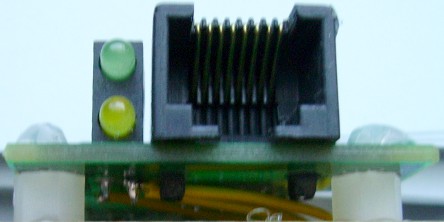Ethernet Card Recycling
If you don't want to spend money and waiting time for a MagJack and a suitable breakout board, here is another solution to get the same in a few minutes. All you need is an old ethernet card (e.g. a 10/100 PCI-card) and with some luck you can build an ethernet breakout board with magnetics and RJ45-connector for free (need only a small piece of perfboard and some straight male header strips and cables)!
How I build my "Schrotty-like" Ethernet connector/breakout board:¶
Here I describe the steps needed for this type of network card. It's an unknown card with an Realtek RTL8139C, but this chip doesn't matter, we need other parts of this card. Other types of network cards may not be usable or may need other steps or additional parts.
That's the card I found in a box of electronic waste:

After some googling around I was amazed that this card has everything I need:
- RJ45 Connector
- Magnetics (LF-H50X - see: Spec of LF-H50X from LANKOM)
- 2kV Ceramic Cap and 4x 75Ohm Resistors (like mentioned here: Microchip-Forum - Thread: "LF-H50X 1:1 transformer")
Luckily all needed components are around the RJ45 connector in the left area (on picture above). So I took a metal saw and cut the pcb next to the LF-H50X (marked on picture above), ensuring not to destroy the metal contacts near the LF-H50X - they will be needed in the next steps.
After removing the metal slot panel from the RJ45 connector I analyzed the connection of the two LEDs with a multimeter and soldered three cables on it:

In the next step I took a small piece of perfboard (42x50mm) and soldered some "straight male header strips" onto it. Then I hot-glued the small ethernet-pcb onto the perfboard and soldered cables between the header strips and pin 1,2,15 and 16 of the LF-H50X (on the upperside of the pcb are large blank soldering contacts which are perfect for this purpose):

Now it's time to connect everything on a breadboard:

And... amazingly it worked perfectly from the first try:

Notes:¶
To improve signal quality over long distances, it may be useful to connect RD0/TD0 to Vout and with 100nF caps to GND (see: Rolfs notebook, search for "To make the connection better over long distances").
I didn't connect RD0 and TD0 because I have no 100nF caps. Nevertheless, my solution works perfectly here.
Have a nice ethernet time! ;-)